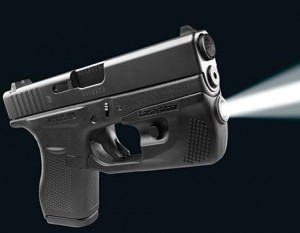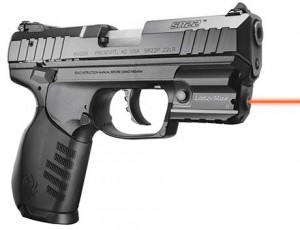by R.K. Campbell | Contributing Editor
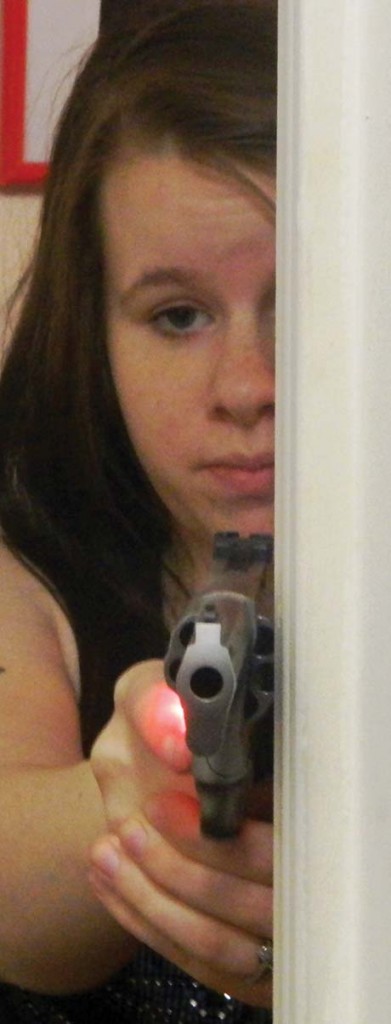
A laser sighting device allows the user to “stand off” and take cover and still make hits on the adversary. And a shooter may gain confidence from practice with the laser that will pay off in a critical situation.
I have to admit to a certain amount of skepticism when first examining laser sights. I do not like to depend upon any device that requires batteries. They tend to fail at the worst moment. Just the same the advantages are such that we may simply learn to do the proper upkeep and learn to fall back on “what we know” when a battery-operated device fails. I attempt to keep an open mind. In the past I have seen cutaway trigger guards, lightweight bullets, various ineffective handgun cartridges, and ungainly attachments by the dozen come and go. I have also observed questionable training procedure. By the same token, a closed mind is a terminal course.
Laser sights for handguns are here to stay by all accounts and seem to be gaining ground. I think that many shooters’ first reaction to laser sights is, “Way cool” but we need more than that to rely upon a device that may save our lives. Let’s look at the three main advantages to the laser sight that I have been able to discern,
- Accurate shot placement. There are situations in which the laser placement of a red or green dot makes for better shot placement.
- Deterrent value. A bright red dot when visible to the felon has been known to give them pause. Listen, if they do not see “shoot” in your eyes it won’t matter, but beyond any doubt our protein-fed ex-con criminal class is conditioned by the cinema and the unerring deadliness of the laser blaster in such scenarios.
- Practice. This just may be the most overlooked advantage of the laser. The laser is a sure means of detecting wobble and jerking a trigger in practice. When engaging in dry-fire practice with the laser turned on, the red dot will either stay in one spot or appear to bounce all over the wall when we press the trigger. If you cannot control the trigger, the laser gyrates all over the target.
Let’s attempt to understand just what a laser is. There are incredibly strong plasma and chemical lasers in use by the military that need not concern us. Lasers are also used in high level communication. Pulse lasers carry information at the speed of light. On the more mundane scale we have laser printers. Lasers fall into the field of non-linear optics. Lasers are Light Amplified by the Stimulated Emission of Radiation. Those familiar with electronics know that an amplifier given too many volts begins to oscillate.
Lasers oscillate. The difference in a laser and other light sources is that the laser beam is very coherent. The longitudinal and transverse coherence is virtually equal-exceptional.
Laser design commonly begins with a tube between two mirrors. The tube is filled with gas. The combination may be helium or neon, and other elements are sometimes used. Voltage is applied to the gas in the tube and the atomic process occurs. Excited neon atoms have a need to shed energy. This energy becomes an important component of the laser beam. The laser’s high intensity has progressed immensely in the past decade. The laser’s progress has resulted in great strides in non-linear optics. Both innovations and fortunes have been the result.
Today laser gear is relatively simple and even combat worthy. My change in viewpoint to accept laser sights has given me many options. I stand by my conclusions. My test program is repeatable and verifiable and I urge all concerned to conduct their own test. After all that is the value of science and, in personal terms, it is your hide that is at stake. The purpose of sights of any type is to hit the target. Anything that helps us hit the target is good. Iron sights require a certain amount of body aiming. At conversational distance you may quickly draw and fire and place the pistol over the target without actually taking a precise aim. This is known as a flash sight picture. You may use only the front sight. At 20 feet or so, typical combat range, body aiming and positioning while looking over the front sight works. But aiming with conventional sights in dim light conditions is sometimes not possible. Laser sights offer the same advantage offered by many optical sights or scopes. Sighting is reduced to focusing on one plane. You do not have to keep front and rear sights aligned and also focus on the target, which is impossible. Conventional wisdom calls for a sharp sight picture and a fuzzy target. I have to state at this point the agencies in which I worked–contrary to what is seen on bad TV–would never have allowed officers to draw the piece at the very hint of a threat and walk around on every search with a drawn weapon. I think sometimes this convinces the felon we are not serious. We had a reason for drawing the weapon.
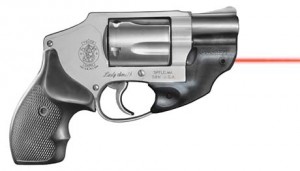
Revolvers fare best with a line of sight laser mounted under the barrel lug. This compact LaserMax unit emits a strong red beam. The configuration may add to comfort in pocket carry, but choose the pocket holster wisely.
That being said, the laser dot has considerable deterrent. The handgun is a weapon of last resort after all other avenues have been exhausted. That red dot can be convincing. Most gunfights are a 50/50 proposition with either side having an equal opportunity for death. If the sight convinces a felon not to fire or to drop his edged weapon, all to the good.
I believe that the laser is useful first as a training tool to highlight problems in trigger compression and the grip. Second, the laser is an ancillary device to the iron sights on the handgun. In bright light the laser may not be visible. Against red clothing the red dot is not visible and against green clothing the green dot laser is not visible. Laser sights are fairly rugged but not infallible. But the advantages outweigh the downside.
I have a few concerns but they are minimal when you understand the nature of the sights. When working up drills in the home the beam may produce unpredictable results that are noted when the beam meets certain surfaces. An issue seldom discussed is reflection and refraction. The laser beam may be bounced from the optimal path by scattering, reflection, refraction, and diffraction. The pattern or mode of pulse of the laser is similar to microwave energy and follows a straight path, but deviation is possible. When we discuss mode frequency and phase you may feel as if you are viewing a “Star Trek” episode—and the fictional “Phaser” is certainly understandable in laser terms. The laws of reflection must be obeyed and the plane of incidence may vary. When the laser meets non transparent matter a laser may be bent into a family of paths. The longitudinal and transverse coherence remain but the light is sent in another direction.
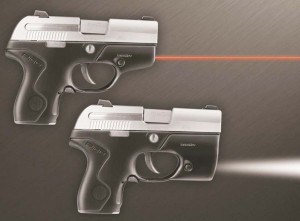
Lights, lasers, red or green? The Beretta Pico is a neat little pistol that is serviced by LaserMax applications.
I am not an expert in the geometric optic field but my experiments confirm that lasers will bounce off glass and highly polished enamel. When directing the beam through glass there was considerable refraction. The beam will not refract off of any clothing I tested. Then there is the famous “Who has the dot?” scenario. This involves a team of officers who have a subject with a hostage at gun point. Several beams are on the subject’s head but one officer has the beam on the hostage—but who has the beam? The answer is simple, check your sights! But this is a scenario well worth considering for a family concerned with personal defense. Practical advantages of the laser sight include the ability to fire around barricades at short range without the need to move your body into the kill zone. You may use the laser sight at a greater distance, keeping your body behind cover. Just the same you will have to allow an avenue for the laser beam to travel but you will be able to make solid hits at five to ten yards while exposing less of your body.
As for laser sight longevity, I have owned several pistols that have fired several thousand rounds with no ill effects. As a test for this report, I used my personal LaserMax equipped Beretta 92 9mm. With the integral guide rod laser in use, the Beretta’s sights and the red dot were in agreement after the simple installation process. I am more concerned with reliability and longevity with this type of device than I consider the tactical implications. I have fired quite a few rounds in this handgun with the device turned on. I have fired high velocity Fiocchi 124-grain Extrema in the Laser/Max Beretta. I have also included a mix of loads that transfer a lot of momentum to the pistol, including the Fiocchi 147-grain Extrema. No shifting of impact was noted and the unit works just as new. After some evaluation this laser sight seems a good option and a worthwhile addition to the tactical battery. They require some effort and skill building from the user. In the end they are well worth the price if they save lives, and claims of their life saving abilities have been borne out on more than one occasion.

